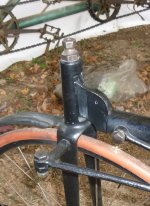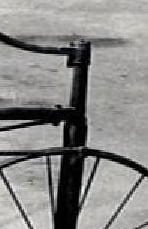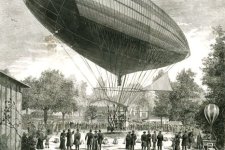ELECTRIC BOAT
MR G.TROUVÉ (1)
(1) We have received several letters from readers who ask about the new electric boat and how to see it work. This notice answers the first question about the second, we will answer as announcing that Mr. Trouvé has been authorized to experiment on the lower lake in the Bois de Boulogne, and that these experiences will be held on 12 June in the afternoon.
M.G.Trouvé, the skilled electrician whose name is well known to our readers, has recently built a small electric motor arranged to be specially adapted to a canoe. He was kind enough to invite us to take part in the first electrical navigation experiment, executed in Paris, May 26, 1881, we hasten to explain these interesting attempts, which have aroused public curiosity in recent weeks, and describe the processes that were used to execute them.
The electric motor built by Mr.Trouvé consists of a bobbin of the Siemens type (2), using a transmission made initially using a simple rope (Fig. 1), and soon through a Vaucanson and Galle chains, this bobbin drives a propeller with three blades in the middle of a suitable sheet metal hollow rudder, as shown in our engraving (Fig. 1). The electric motor itself is attached to the top of the rudder, so that it follows in its movements the same time as the propeller.
(2) In a note recently presented at the Academy of Sciences, M.Trouvé said to have increased the effectiveness of the Siemens bobbin by modifying it as follows: the pole faces, rather than portions of a cylinder whose axis coincides with that of the system are shaped snail-like, so that they approach gradually turning their surfaces from those magnets, until the posterior escapes the pole of the magnet. The action of repulsion begins, so that dead spots are virtually eliminated.
M.Trouvé said that this improvement was demonstrated by a simple experiment. He built two Siemens bobbins of the same diameter, same length and same winding, only one of which had been amended in the manner indicated, they were successively used as a substitute to each other in an electric motor, and using the same battery with the modified bobbin an increase of work was realized.
Readers wishing to have more details on this can be made to the Records of meetings of the Academy of Sciences.
M.Trouvé also builds motors with two bobbins coupled, as used by the boat in this experiment.
This motor with its accessories weighs no more than 5 kg. It is placed in the back of an elegant little canoe, le Téléphone, which is 5.5m long and 1.2m wide and weighs 80 kg. In the middle of the canoe are placed two potassium bichromate batteries, six cells each and the total weight of 24 lbs.
M.Trouvé uses two batteries, because batteries are thus more manageable. These two batteries have the added advantage that they can be used separately or simultaneously. During the night, move with one battery and light up electrically with each other. The batteries are connected to the motor via two cords at the same time the wire covers and guide ropes to operate the rudder (Fig. 2). These cords are provided with two handles, which have switches that allow current to pass or intercept it at will.
The electric motor of the boat is completely independent and can be adapted to any boat. M.Trouvé placed the motor on the rudder, so as not to damage the boat he operates, and to leave open the possibility of using both oars as well as electricity.
The ingenious builder, before adopting as a means of transmission the Vaucanson and Galle chains, has experimented with different modes of transmission, by gears, worms and friction and introduced us to the summary of his essays which we reproduce.
The gear transmission angle, gives good results, but these bodies require too much precision and require too much care to avoid shocks almost inevitable. In addition, sea grass, tree branches, sand, mud, are all obstacles to their effective functioning.
Transmission worm is excellent and perhaps the best, if the mechanism operating in the air as it would be easy to have a good greasing. But the water is quite different, especially if water sea grasses, branches, sand and mud are as annoying obstacles with the gears. However, under exceptional purity of the water on the surface which you sail.
M.Trouvé employment in conjunction with other systèmes. Le friction system gave M.Trouvé the best performance, but in the application, it presented some difficulties in several experiments, its operation has not always been perfect for a minor forces.

Fig. 1. The electric motor of the boat M.G.Trouvé with the rudder and propeller. (Figure made from the first model with one bobbin.)
Vaucanson chain and Galle chain are the two bodies for the experimenter that best met all needs, although the yield is slightly lower than other systems. This inferiority is largely compensated by the regularity of operation and robustness of the system.
In the first experiment of May 26, M.Trouvé and I sat in the boat, which easily followed the course of the Seine on two different occasions to the Pont Royal and then down the course of the Seine to the Pont de la Concorde. Le Téléphone has a navigation run that lasted about forty-five minutes.
The experiment was repeated that evening by MM.Trouvé, W. of Fonvielle and Schlesinger, but it was carried out in a much more accurate on May 31 at 9:00 am, in the presence of MM. G. Berger, commissioner general of l'Exposition universelle d'électricité, Antoine Breguet, the learned director of la Revue scientifique, Lartigue, Edward Hospital, Fricéro, Russian naval officer, and a few other people, including my brother and I. On six separate occasions, le Téléphone, containing three persons, easily ascended the course of the Seine, for a distance of 200 meters, exactly measured from the pier of the steamer le Touriste, to the cold baths at the Pont Royal. We found that the boat went up the current with a speed of 1 meter per second, and came down with a speed of 2.5m. The current of the Seine, not far from the shore, at about a speed of 20 centimeters per second.
New trials were held June 2 in the presence of Russian Admiral Likhatchof, scholars and several specialists, and amateur navigators.
These experiments, which offer a genuine interest in the experimental point of view, strongly excited the attention of spectators gathered on the Pont Royal, and it is not without surprise that we saw le Téléphone back later this Seine without oars and without smoke generally inseparable from the steam engine.
We hope that these attempts will be the prelude to larger buildings that will surely run when the power source will be refined as it should be borne in mind that the battery is of little benefit to handle, its assembly is awkward and duration of its operation is limited.
The experiments of M.Trouvé reminded us of the attempts on the Neva in 1839 by Jacobi on navigation by electricity. We read with interest in the wonders of science documents that the illustrious inventor of electroplating had communicated itself to Mr. Louis Figuier. We reproduce here as a historical curiosity.
The voltaic apparatus that provided electricity to the electric motor Jacobi, was a Grove pile, consisting of 64 zinc and platinum cells, which offered a total area of 16 square feet. But when the public experiment was performed as we recall, a second machine just like it, and provided with a battery of the same force, was added to the first, these two machines coupled, gathered their effects by acting on the same shaft. The battery that was used was therefore composed of 128 Grove cells and had a total area of 32 square feet.
View attachment 1
Fig. 2. The boat electrical M. G. Found in the first experiment performed on the Seine in Paris, May 26, 1881.
The power of the electric current was such that a platinum wire 2 meters long, and the size of a piano string, was immediately reddened to its whole extent, by the voltaic current.
The release of nitrous gases from the battery, was so intense that inconvenienced the highest degree operators, and that he forced several times to interrupt the experiment. Spectators on the banks of the Neva attended the event, and were forced to leave their own place, because of the painful and suffocating smell of nitrous gases escaping from the unit and was driven by wind, to the banks of the river.
The boat, which was equipped with paddle wheels and manned by twelve persons, sailed for several hours on the waters of the Neva, against the current, and despite a strong wind.
We see that the Jacobi experience is worthy of note and should be cited as the source of electric navigation.
We hope that further progress soon will crown the efforts of Jacobi's successor, we will add the new boat M.G.Trouvé electrical work to the public for the duration of the Universal Exhibition of Electricity, where we will navigate le Téléphone in a basin which is not less than 18 meters in diameter.
Gaston Tissandier








